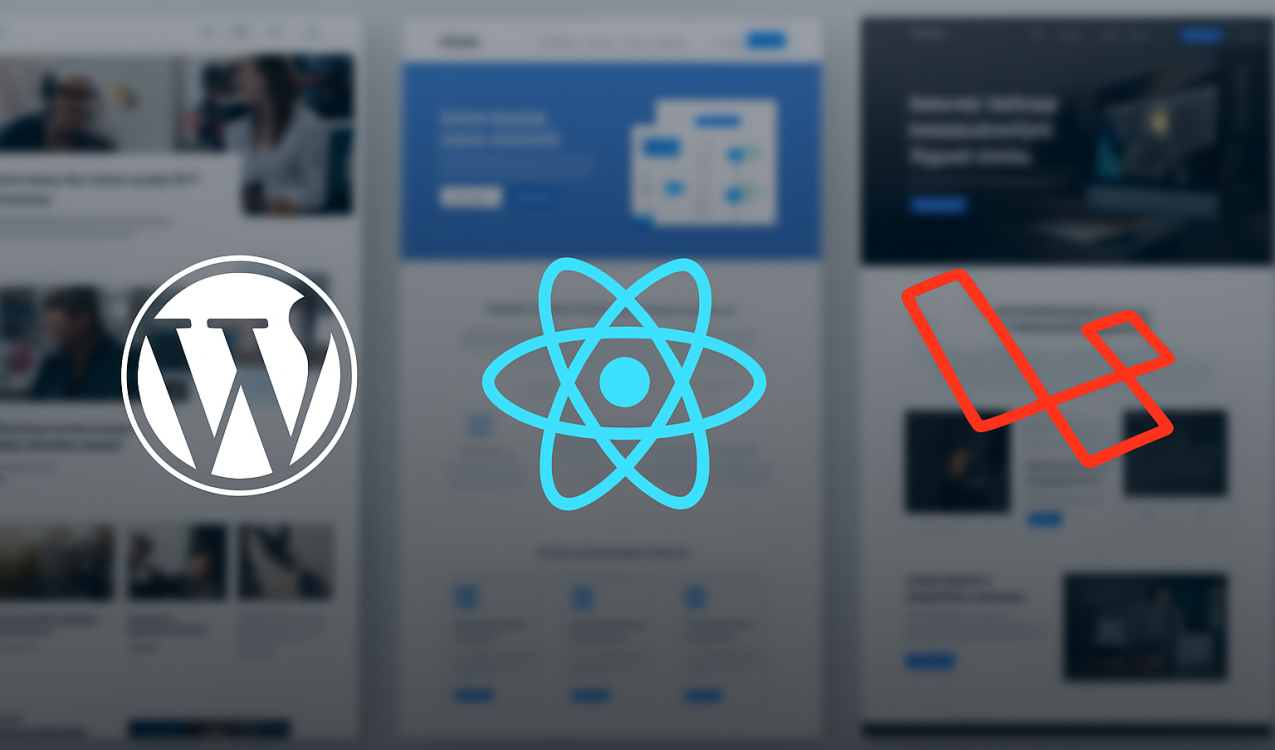In the world of web development, the tools you choose can significantly influence your project’s outcome. Among the many platforms and frameworks available today, WordPress, React, and Laravel stand out as some of the most widely used and versatile solutions. Each has its strengths and ideal use cases, but choosing the right one depends on the specific needs of your project.
This article will help you understand the core differences between these three technologies, when to use them, and how to decide which one is best for your business, startup, or client project.

What is WordPress?
WordPress is a content management system (CMS) initially designed for blogging, but it has since evolved into a robust platform for building websites of all kinds. As of 2025, over 40% of all websites on the internet are powered by WordPress.
Key Features:
- Easy to install and use
- Massive plugin ecosystem
- Wide range of themes
- User-friendly admin dashboard
- Suitable for non-developers and developers alike
Best For:
- Blogs and magazines
- Small business websites
- Portfolio sites
- E-commerce (via WooCommerce)
- Non-technical users who want to manage content easily
Pros:
- Fast setup
- Huge community and support
- SEO-friendly
- Low cost of development
Cons:
- Can become slow with too many plugins
- Security vulnerabilities if not maintained
- Less flexible for custom applications
What is React?
React is a JavaScript library developed by Facebook for building interactive user interfaces, particularly for single-page applications (SPAs). It’s component-based, meaning developers build isolated pieces (components) that come together to form a complete interface.
Key Features:
- Virtual DOM for faster rendering
- Component-based architecture
- Strong community support
- Works well with APIs and dynamic content
Best For:
- Modern web applications
- Dashboards and admin panels
- Interactive UI/UX projects
- Real-time apps (e.g., chat, collaboration tools)
Pros:
- Lightning-fast performance
- Reusable components
- Great ecosystem (Next.js, Redux, etc.)
- Scales well for large apps
Cons:
- Requires more setup than WordPress
- Steeper learning curve for beginners
- Needs backend integration (not full-stack by default)
What is Laravel?
Laravel is a PHP framework for backend development, known for its elegant syntax and robust features. It follows the MVC (Model-View-Controller) architectural pattern and includes built-in tools for routing, authentication, and database interaction.
Key Features:
- Blade templating engine
- Built-in authentication and security features
- Eloquent ORM (database interaction)
- Artisan CLI for commands and automation
- RESTful routing
Best For:
- Full-featured web applications
- APIs and backend services
- E-commerce platforms
- Custom enterprise applications
Pros:
- Clean and maintainable code
- Strong backend logic handling
- Secure and scalable
- Active developer community
Cons:
- Requires deeper technical expertise
- Not ideal for content-heavy marketing sites
- Frontend still needs React/Vue for modern UI
Comparing the Three: Side-by-Side
| Feature | WordPress | React | Laravel |
|---|---|---|---|
| Type | CMS | Frontend Library | Backend Framework |
| Tech Stack | PHP, MySQL | JavaScript | PHP, MySQL |
| Ideal For | Websites, Blogs | Web Apps, SPAs | Web Apps, APIs |
| Customizability | Moderate | High | High |
| Performance | Good | Excellent | Excellent |
| Ease of Use | Very Easy | Moderate | Moderate/Hard |
| Learning Curve | Low | Medium | High |
| Cost to Develop | Low to Medium | Medium | Medium to High |
Which One Should You Choose?
📍 Choose WordPress if:
- You need a website quickly with minimal coding
- Your content changes often (blogs, portfolios, events)
- You’re not a developer, or your client needs an easy dashboard
- You have a limited budget
📍 Choose React if:
- You’re building a modern, highly interactive web app
- You want complete control over the frontend UI/UX
- Your application needs real-time data and responsiveness
- You plan to use a headless CMS or API backend
📍 Choose Laravel if:
- You need a secure, scalable backend for a custom application
- Your project includes complex business logic or data workflows
- You are comfortable with PHP or have a backend development team
- You want to build an API-first app or full-stack system
Can They Work Together?
Absolutely. In fact, Laravel + React is a very popular full-stack combination, where Laravel handles the backend (authentication, database, APIs) and React manages the frontend UI. Similarly, WordPress can be used headless (as a backend CMS), with React on the front for dynamic interfaces.
Combining technologies allows you to build robust, scalable, and modern applications that make the best use of each tool’s strengths.
Final Thoughts
There is no one-size-fits-all answer in web development. Choosing between WordPress, React, and Laravel depends entirely on your project goals, timeline, budget, and technical expertise.
If you’re building a simple business website or blog, WordPress might be the fastest and most economical choice. For interactive apps and custom UI, React stands out. And for powerful backend systems with complex logic, Laravel provides the control and security needed.
Evaluate your project needs carefully, and if you’re still unsure, consult with a development professional. The right tech stack is the one that helps you deliver a great product, on time, and within budget.
Need help deciding or building? Nexavi can help you choose the best technology for your project and bring your vision to life.


1 Comment
http://Boyarka-Inform.com/
Thanks foor another iinformative web site. The
pace else could I get that thpe of information written inn such
a perfect manner? I’ve a project that I’m just now operating on, and I have been at
the look outt for such information. http://Boyarka-Inform.com/